Asking the right survey question types is essential to collecting valuable insights from your customers. Regardless of how you share your survey, the questions themselves are the most important aspect.
Survey question falls into two categories: closed-ended questions and open-ended questions.
Closed-ended questions ask respondents to choose from a pre-set list of answers and will provide you with quantitative data, e.g., multiple-choice questions.
Open-ended questions allow respondents to write free-form answers, e.g., text and comment boxes.
What are the different survey question types?
Here’s a list of the most common survey question types along with some examples to help you create your own survey.
1. Multiple-choice questions
Multiple-choice questions provide a selection of answer choices for respondents to choose from. These questions are efficient because they allow respondents to scan the answers and choose the most appropriate one.
There are two types of multiple-choice questions: single-select and multi-select.
Single-select questions
Single-select questions only allow a single answer choice and work well where the answer you provide different opinions or ideas. For example, binary questions must be single-select because the answer choices represent two separate opinions.

Multi-select questions
Whereas multi-select questions enable respondents to select one or more answer choices (which can be defined by you). These work when you want respondents to express a range of opinions or preferences about the same topic, e.g. “please select all that apply”.
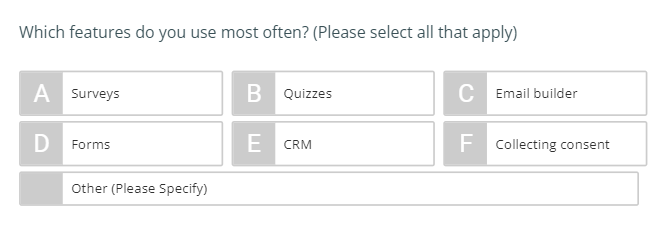
The downside of multiple-choice questions is that they restrict respondents to a set of answers defined by you. If they have an opinion or experience that is not present in that list, they may not know how to answer.
It can be difficult to make sure your answer options are collectively exhaustive, especially when you should have more than 7 or 8 answer choices per question. If you’re struggling with this, we’d recommend adding an ‘other’ answer option to allow respondents to write a custom answer.
2. Rating scales
Rating scale questions are numbered scales (usually from 1 to 10) that ask respondents to choose a number on that scale.
These question types should have text at either end in order to give respondents context of what each number represents. These are really useful when collecting feedback on customer service or product delivery, as they give you a quantifiable overview of how well you’re doing.
For example, for a Net Promoter Score question, 0 would be labeled with Not Likely at all, and 10 would be labeled with Extremely likely.

3. Slider questions
Sliders are similar to rating scales in that they require respondents to answer using a scale. The only difference is that they use a slider to choose that number as opposed to clicking a box.
The bonus to these question types is that they’re a little more interactive, and give you the opportunity to switch things up in your survey without impacting the data you’re collecting.

4. Likert scales
Likert Scale questions ask respondents the degree to which they agree or disagree with a question or statement.
They’re great for finding out how people feel about a particular topic.
For example, if you’re conducting a customer satisfaction survey you may want to find out how customers felt about the value for money of your product:
“Do you think our product is good value for money?”
Then your answer options can range from “Not at all good value for money” to “Extremely good value for money”.

5. Matrix questions
Matrix questions allow you to ask multiple questions that all share the same Likert Scale. They’re great as they allow you to more questions without your respondents having to change the way they think about answering each question.
However, the disadvantage to these questions is that they can be quite bulky on the page. We’d recommend sticking to 3 or 4 questions or statements per matrix.
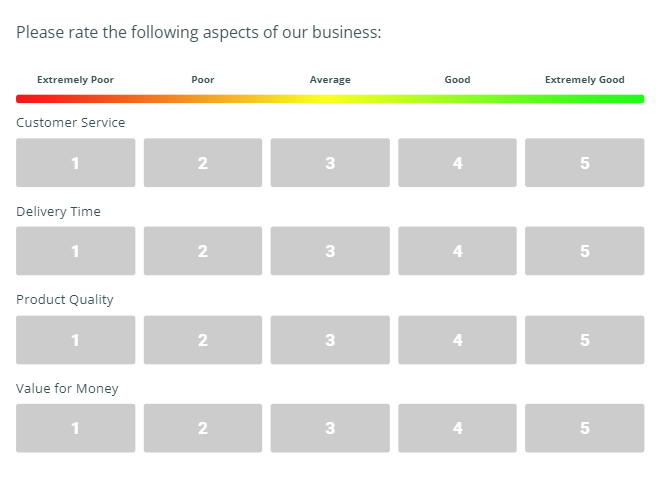
6. Order ranking questions
Order ranking questions do what it says on the tin, they allow respondents to order answer choices by their own preference.
The results from these question types will give you the average position of each answer option, so you can identify the most popular answer.
It’s worth noting that you should only use these question types when your respondents are familiar with all the options. Otherwise, they might struggle with giving them a suitable order.
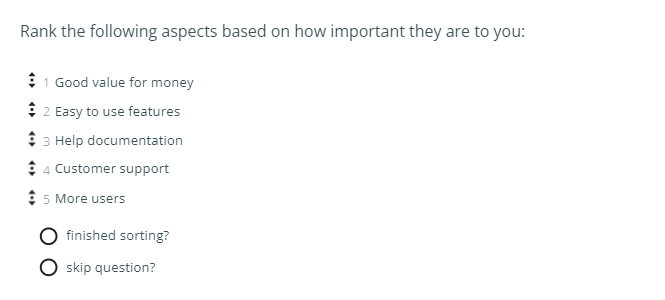
7. Dropdown questions
Dropdown questions are similar to multiple-choice, but naturally encourage longer lists of answer options. They are more suitable for this as the answers themselves are hidden on the page until the respondent opens the dropdown. Then, they simply need to scroll through the different answers until they find the most applicable.
They work especially well for response options that would be easier to read when listed vertically rather than across the page. For example, Age Ranges, Countries, States, Job Roles, Etc.
The best practice for dropdowns is always to write answers in a logical order. For the most part, this would mean listing answers alphabetically. This makes it easier for respondents to find what they’re looking for.

8. Net Promoter Score
Net Promoter Score (NPS) is the industry standard for measuring customer loyalty. You can do this by asking one simple question:
“How likely are you to recommend [Company/ Product/ Service] to a friend or colleague?”
Customers then choose a number on a scale of 0 (Not very likely) to 10 (Extremely Likely).
This is essentially a scaled question, but most survey platforms will include this as a separate question type. This is because the chart for NPS would look very different from that of an average scaled question.
Your NPS is calculated by dividing the percentage of promoters (selected 9 to 10) by the percentage of detractors (selected 0 to 6).
If you want an example of how this would be done, check out this handy NPS calculator.

9. Text questions
As we mentioned in the introduction, text-based questions are open-ended in nature as they allow respondents to write their own answers.
Text questions are a valuable source of feedback, and we encourage you to use them in your surveys. They can give you a great perspective of why respondents chose answers to close-ended questions and allow them to go into more detail on their experiences.
However, because open-ended questions encourage custom feedback the answer tends to be longer and more time-intensive to analyze.
But we think the ‘bucketing’ method is a great way to analyze qualitative data.

10. Picture choice questions
Picture choice questions function in much the same way as multiple-choice questions but allow respondents to select an image.
Not only do these questions add an exciting visual element to your survey, but they are also excellent for concept testing. Whether you’re designing a new product, logo, or ad, you can get accurate and detailed feedback.
We offer three different variants of this survey question type: single-select, multi-select, and comments.

Picture choice (single-select)
Respondents can select a single image from among those provided.
Picture choice (multi-select)
Multiple images can be selected by respondents, the number is defined by the survey creator.
Picture comments
Instead of selecting an image, picture comments questions include a text field for respondents to leave feedback beneath the images.
11. Demographic questions
Demographic surveys questions are those that allow you to identify different things about your respondents. These can include:
- Age
- Gender
- Income
- Location
These questions are essential to learning more about your audience and building customer profiles.
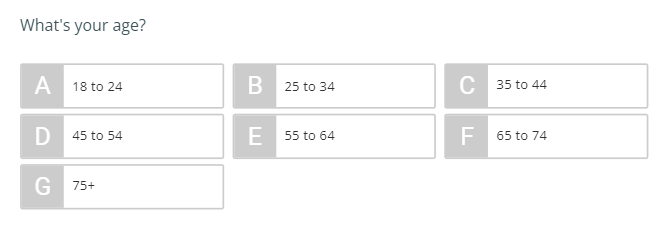
12. Date questions
Date question types allow you to collect dates and date ranges from your respondents.
These are excellent for event surveys, where you’d need to link responses to a certain day or register attendees for an event.
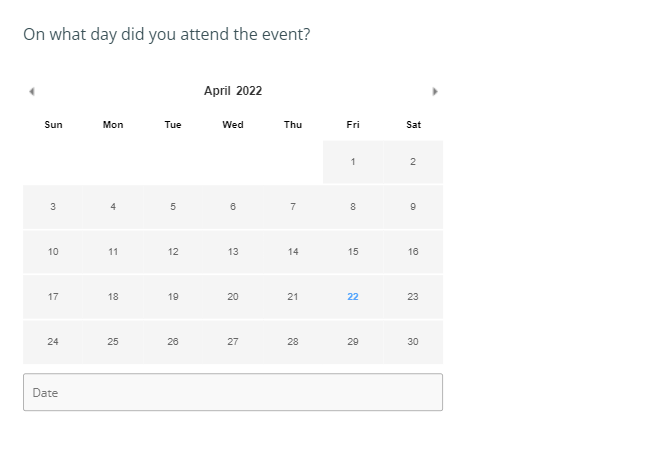
13. Star ratings
Star rating questions ask customers to rate something along a scale of stars.
You’d most likely have seen these on review sites, but they can be used for a variety of purposes. Whether you’re collecting feedback on your customer support process or the design of your website.

Tips for writing survey questions
Now that you’ve got your bearings with all the different question types, you’ll need to crack on with creating your survey. To help you get started, here are our top tips for writing good survey questions:
- Keep questions short and clear
- Don’t ask double-barreled questions
- Avoid loaded words and phrases
- Don’t write leading questions
Generally, you always want to make sure your survey is accessible. So, you’ll need to use a tool that’s mobile-friendly.
All question types are mobile-friendly with Shout by default, so you won’t need to create surveys that are mobile-specific.
We also recommend that you test your survey with your team or a friend before sharing it with your customers. This will give you a sneak peek into what your data will look like and will let you know if you need to change any question types before launching.
How to choose the right survey question type
Often the question type will be self-explanatory, like Net Promoter Score, but there are times when you have to make a choice.
The type of question you use will often depend on what data you want to collect and what you intend to do with that data.
Sometimes, all you’ll need is quantitative data that allows you to draw statistical conclusions. Other times, you may need something more descriptive.
Ask yourself what you’re trying to achieve with this survey, and what problem are you trying to solve. Then think about what feedback or data you’ll need in order to achieve this.
Switching up the question types you use can also improve engagement from respondents and increase your response rate. This just stops the format from becoming stale and will fend off survey fatigue.
Wrapping up
Choosing the right survey question type is a very important aspect of good research. Hopefully, we’ve covered everything you need to know above.
If you don’t have time to worry about each individual question type, we’d recommend that you use a survey template to get started. It’ll take you less time to chop and change those than it would to build a survey from scratch.




